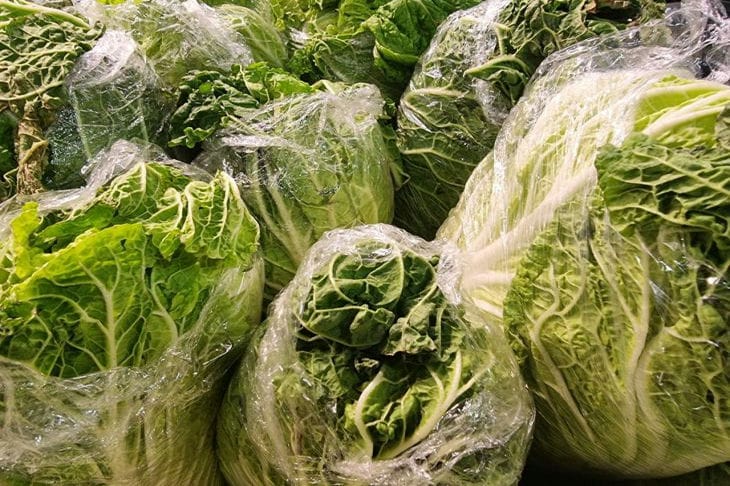Chinese cabbage: how to grow in your garden
Chinese cabbage has been grown in China, Korea and Japan for many centuries.
It has been encountered in Europe since the 20th century, and is becoming increasingly popular these days.
With a calorie content of only 10-18 kcal per 100 g, Chinese cabbage is considered very low-calorie, says Anastasia Kovrizhnykh .
It is especially often used as greens in various salads, and is also used in the preparation of soups, side dishes and marinades.
In its native land, Chinese cabbage is usually pickled to make a type of fermented sauerkraut, which can also be very spicy.

In South Korea, kimchi is a very popular dish – spicy fermented vegetables, the main ingredient of which is Chinese cabbage. Archaeological finds of clay pots show that this preparation has been practiced for more than 2,000 years.
Chinese cabbage seeds
There are currently various types of Chinese cabbage seeds available for sale, including varieties with reddish foliage.
In addition to the older varieties, modern F1 hybrids are usually prevalent in home improvement store garden centers. Some F1 hybrids are now resistant to clubroot.
Growing Chinese cabbage
Tasty Chinese cabbage can be grown in your home garden without any problems. This crop prefers fertile soil in a sunny or partially shaded bed.
The need for heat is not as high as one might expect from its place of origin. Much more important is a place protected from the wind and a good supply of moisture.
Chinese cabbage likes well-loosened soil in the garden bed. Like most types of cabbage, it is one of the most demanding crops for nutrients.
The soil should be improved before planting young plants. For this purpose, organic fertilizers with a long-term effect can be used.
Alternatively, you can add compost or a little manure from organic livestock.
Chinese cabbage is usually planted quite late, making it a good follow-up crop for plants that have been harvested earlier, such as carrots or beans.
Sowing should be done no earlier than mid-June to early August. You can grow seedlings in small pots or sow seeds directly into the garden bed.
The sowing depth is 1.5 cm. Plants should be located at a distance of 30-40 cm from each other, and between rows the gap is 50-60 cm. At a soil temperature of 15 to 18 ° C, seedlings appear within a week.
If you loosen the soil regularly, the cabbage will thank you with healthy growth and a high yield. Make sure that the bed does not dry out, the plants require regular watering, but it is important to avoid over-watering.
Harvesting and storing Chinese cabbage
Depending on the variety, Chinese cabbage is harvested in about 75-95 days. Depending on the sowing time, the harvest can be in September, October, and even November.
Chinese cabbage tolerates light frosts without problems and, if not needed in the kitchen, should remain in the garden as long as possible.
You can protect plants from frost using fleece, large cardboard boxes or spruce branches.
Later and larger heads of cabbage are better and store longer. However, do not wait too long, because too low temperatures damage Chinese cabbage.
When harvesting, remove the outer leaves and cut the plant as low as possible at the base of the root. The petioles should not be damaged, as this is a gateway for pathogens. Chinese cabbage quickly begins to rot during storage.
Chinese cabbage can easily be stored in the refrigerator for about a week. If you wrap the heads in damp paper or towels, they can stay in the refrigerator for several weeks. Chinese cabbage also stores well in a cool cellar.
This type of cabbage is not recommended for freezing, but you can process it into delicious kimchi and store it for several months. Kimchi can best be described as fermented and spicy pickled sauerkraut.
Pests and diseases of Chinese cabbage
Symptoms range from leaf damage by slugs, flea beetles, cabbage flies to clubroot, a fungal disease that causes thickening of the roots of Chinese cabbage.
Small holes on the leaves of Chinese cabbage indicate flea beetle infestation. Such infestation occurs primarily when the soil dries out, so regular watering is the most effective method of prevention.
Cabbage butterflies, which initially seem harmless, prefer to lay their eggs on young cabbage leaves.
As soon as the caterpillars hatch, they immediately begin to eat the leaves of the vegetable. To prevent this, it is recommended to regularly check the cabbage thoroughly.
It also makes sense to use a net to protect against birds. Fragrant plants planted between Chinese cabbage or as a border of the bed also have a deterrent effect on white cabbage. For this purpose, you can use peppermint, thyme, marigolds, tomatoes.
Clubroot is considered a very harmful plant disease, which is why it takes a long time to combat it. Affected plants begin to wither and their roots become noticeably thicker.
Spores of this fungal disease usually survive in the soil for several years, so recommended crop rotation should be followed.
Avoiding acidic soil and waterlogging are some of the most effective forms of prevention.
Earlier, the expert explained why the soil in the greenhouse turns green.
